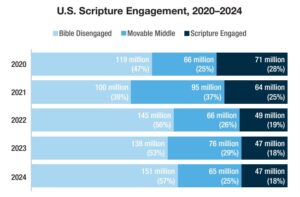
ATLANTA (BP)–The typical Southern Baptist church has 233 total members, of whom 168 are resident members. The current pastor has been at the church three to four years. The church has 70 people in its Sunday morning worship service; reported five baptisms and five other additions during the 1994-95 church year; has 98 enrolled in Sunday school, with 55 in attendance; and gives 12 percent of tithes and offerings to missions.
This profile was derived by Home Mission Board researchers from information supplied by more than 36,500 churches through the 1995 Annual Church Profile, according to Phil Jones, HMB research director. “It is a picture of what I have called the ‘typical’ SBC church, which is a compilation of the median statistics of all the reporting churches. That means half of all SBC churches are larger and half are smaller on any particular statistic,” Jones explained.
The information indicates the current status of SBC churches as well as trends, according to Jones.
“While large, growing churches receive a great deal of attention, the Southern Baptist Convention continues to be composed primarily of small churches,” Jones summarized. “Seventy percent of SBC churches have 400 or fewer members, and less than 10 percent have more than 900 members.”
Jones also found that although most churches are small, 70 percent of Southern Baptists are members of larger churches. “A few mega-churches with several thousand members each can more than compensate for hundreds of small churches,” Jones said.
The study also shows some growth indicators of the typical SBC church in 1995 may be smaller than the typical church 10 or 20 years ago, but Jones said reasons for declines are difficult to pinpoint.
“There were some problems with data collection the past couple of years causing some churches to not report, although I don’t believe that would dramatically affect the outcomes,” Jones said. “Some declines in the typical church baptism rate, Sunday school enrollment and attendance, and WMU enrollment appear to be due to declines in older established churches.”
Jones explained not all declines are negative. “The decrease in the median number of resident members is not really an unfavorable trend since the decline is due to the influx of new, smaller churches into the convention. In fact, the baptism rate would have declined even further if not for the starting of new churches in the convention.”
The study showed substantial increases in church receipts; however, the increases were smaller when adjusted for inflation. “The income for the typical SBC church in 1995 would purchase just 14 percent more than in 1972,” Jones said. Total mission giving fared even better over time, reflecting what Jones called the “missions mindedness of the typical SBC church.”
Although the typical church has experienced some decline, statistics for the entire Southern Baptist Convention continue to increase. The total number of members reported by SBC churches has grown 34 percent since 1970, a time when most major Protestant denominations experienced serious declines.
Combined income of SBC churches grew more than 200 percent between 1978 and 1995 to $5.6 billion. When adjusted for inflation, the growth in purchasing power still increased 29 percent. And, missions giving over the same period grew 170 percent.
SBC leaders told Baptist Press the typical church figures are not a surprise and cited such trends as reasons for recent, ongoing and planned changes at most SBC agencies.
“Of course, we are interested in this trending data which indicates some declines at the local church level,” said Ernest J. Kelley, HMB interim president. “However, we must not lose sight of the fact that the SBC is very healthy and continues to grow despite strong trends to the contrary by other denominations. Our agencies and churches are well aware of the need to be more effective in all of our ministries.” Kelley cited as an example the present reorganization of national SBC agencies.
“The ‘Covenant for a New Century’ was initiated to deal with these very trends by closing, merging, restructuring and refocusing the work of the agencies to help churches be more effective in reaching people for Christ, which will result in more and growing churches,” Kelley said.
–30–













